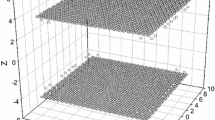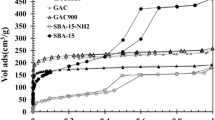Abstract
The activation of carbon dioxide (CO2) by catalytic systems comprising a transition metal (Co, Cu,Ni) on an activated carbon (AC) support was investigated using a combination of different theoretical calculation methods: Monte Carlo simulation, DFT and DFT-D, molecular dynamics (MD), and a climbing image nudged elastic band (CI-NEB) method. The results obtained indicate that CO2 is easily adsorbed by AC or MAC (M: Cu, Co, Ni). The results also showed that the process of adsorbing CO2 does not involve a transition state, and that NiAC and CoAC are the most effective of the MAC catalysts at adsorbing CO2. Adsorption on NiAC led to the strongest activation of the C–O bond, while adsorption on CuAC led to the weakest activation.

Models of CO2 activation on: a)- activated carbon; b)- metal supported activated carbon (M-AC), where M: Co, Cu, Ni







Similar content being viewed by others
References
Zangeneh FT, Sahebdelfar S, Ravanchi MT (2011) Conversion of carbon dioxide to valuable petrochemicals: an approach to clean development mechanism. J Nat Gas Chem V20(3):219–231. doi:10.1016/S1003-9953(10)60191-0
Arenaa F, Mezzatesta G, Zafarana G, Trunfioa G, Frusteri F, Spadaro L (2013) How oxide carriers control the catalytic functionality of the Cu–ZnO system in the hydrogenation of CO2 to methanol. Catal Today 210:39–46. doi:10.1016/j.cattod.2013.02.016
Zhou G, Wu T, Xie H, Zheng X (2013) Effects of structure on the carbon dioxide methanation performance of Co-based catalysts. Int J Hydrog Energy 38:10012–10018
Janke C, Duyar MS, Hoskins M, Farrauto R (2014) Catalytic and adsorption studies for the hydrogenation of CO2 to methane. Appl Catal Environ 152–153:184–191. doi:10.1016/j.apcatb.2014.01.016
Karelovic A, Ruiz P (2013) CO2 hydrogenation at low temperature over Rh/γ-Al2O3 catalysts: effect of the metal particle size on catalytic performances and reaction mechanism. Appl Catal Environ 113–114:237–249. doi:10.1016/j.apcatb.2011.11.043
Cai M, Wen J, Chu W, Cheng X, Li Z (2011) Methanation of carbon dioxide on Ni/ZrO2-Al2O3 catalysts: effects of ZrO2 promoter and preparation method of novel ZrO2-Al2O3 carrier. J Nat Gas Chem 20:318–324. doi:10.1016/S1003-9953(10)60187-9
Graca I, González LV, Bacariza MC, Fernandes A, Henriques C, Lopes JM, Ribeiro MF (2014) CO2 hydrogenation into CH4 on NiHNaUSY zeolites. Appl Catal Environ 147:101–110. doi:10.1016/j.apcatb.2013.08.010
Liu H, Zou X, Wang X, Lu X, Ding W (2012) Effect of CeO2 addition on Ni/Al2O3 catalysts for methanation of carbon dioxide with hydrogen. J Nat Gas Chem 21:703–707. doi:10.1016/S1003-9953(11)60422-2
Zhou G, Wu T, Xie H, Zheng X (2013) Effects of structure on the carbon dioxide methanation performance of Co-based catalysts. Int J Hydrog Energy 38:10012–10018. doi:10.1016/j.ijhydene.2013.05.130
Jwa E, Lee SB, Lee HW, Mok YS (2013) Plasma-assisted catalytic methanation of CO and CO2 over Ni–zeolite catalysts. Fuel Process Technol 108:89–93. doi:10.1016/j.fuproc.2012.03.008
Takanoa H, Izumiyaa K, Kumagai N, Hashimoto K (2011) The effect of heat treatment on the performance of the Ni/(Zr–Sm oxide) catalysts for carbon dioxide methanation. Appl Surf Sci 257(19):8171–8176. doi:10.1016/j.apsusc.2011.01.141
Hwang S, Lee J, Hong UG, Baik JH, Koh DJ, Limc H, Song IK (2013) Methanation of carbon dioxide over mesoporous Ni–Fe–Ru–Al2O3 xerogel catalysts: effect of ruthenium content. J Ind Eng Chem 19(2):698–703. doi:10.1016/j.jiec.2012.10.007
Liu X, Bai S, Zhuang H, Yan Z (2012) Preparation of Cu/ZrO2 catalysts for methanol synthesis from CO2/H2. Front Chem Sci Eng 6(1):47–52. doi:10.1007/s11705-011-1170-4
Gao P, Li F, Zhan H, Zhao N, Xiao F, Wei W, Zhong L, Wang H, Sun Y (2013) Influence of Zr on the performance of Cu/Zn/Al/Zr catalysts via hydrotalcite-like precursors for CO2 hydrogenation to methanol. J Catal 298:51–60. doi:10.1016/j.jcat.2012.10.030
Kong H, Li HY, Lin GD, Zhang HB (2011) Pd-decorated CNT-promoted Pd–Ga2O3 catalyst for hydrogenation of CO2 to methanol. Catal Lett 141(6):886–894. doi:10.1007/s10562-011-0584-4
Iablokov V, Beaumont SK, Alayoglu S, Pushkarev VV, Specht C, Gao J, Alivisatos AP, Kruse N, Somorjai GA (2012) Size-controlled model Co nanoparticle catalysts for CO2 hydrogenation: synthesis, characterization, and catalytic reactions. Nano Lett 12(6):3091–3096. doi:10.1021/nl300973b
Ahmed N, Morikawa M, Izumi Y (2012) Photocatalytic conversion of carbon dioxide into methanol using optimized layered double hydroxide catalysts. Catal Today 185(1):263–269. doi:10.1016/j.cattod.2011.08.010
Uner D, Oymak MM (2012) On the mechanism of photocatalytic CO2 reduction with water in the gas phase. Catal Today 181(1):82–88. doi:10.1016/j.cattod.2011.06.019
Beuls A, Swalus C, Jacquemin M, Heyen G, Karelovic A, Ruiz P (2012) Methanation of CO2: further insight into the mechanism over Rh/γ-Al2O3 catalyst. Appl Catal Environ 113–114:2–10. doi:10.1016/j.apcatb.2011.02.033
Ye J, Liu C, Ge Q (2012) DFT study of CO2 adsorption and hydrogenation on the In2O3 surface. J Phys Chem 116(14):7817–7825. doi:10.1021/jp3004773
Yang Y, Evans J, Rodriguez JA, White MG, Liu P (2012) Fundamental studies of methanol synthesis from CO2 hydrogenation on Cu(111), Cu clusters, and Cu/ZnO(0001). Phys Chem Chem Phys 12(33):9909–9917. doi:10.1039/c001484b
Li HJ, Ho JJ (2010) Density functional calculations on the hydrogenation of carbon dioxide on Fe(111) and W(111) surfaces. J Phys Chem 114(2):1194–1200. doi:10.1021/jp909428r
Zhang ST, Yan H, Wei M, Evans DG, Dua X (2014) Hydrogenation mechanism of carbon dioxide and carbon monoxide on Ru(0001) surface: a density functional theory study. RSC Adv 4:30241–30249. doi:10.1039/C4RA01655F
Ren J, Guo H, Yang J, Qin Z, Lin J, Li Z (2015) Insights into the mechanisms of CO2 methanation on Ni(111) surfaces by density functional theory. Appl Surf Sci 351:504–516. doi:10.1016/j.apsusc.2015.05.173
Bothra P, Periyasamy G, Pati SK (2013) Methane formation from the hydrogenation of carbon dioxide on Ni(110) surface—a density functional theoretical study. Phys Chem Chem Phys 15(2013):5701–5706. doi:10.1039/C3CP44495C
Pan QS, Peng JX, Wang S, Wang SD (2014) In situ FTIR spectroscopic study of the CO2 methanation mechanism on Ni/Ce0.5Zr0.5O2. Catal Sci Technol 4:502–509. doi:10.1039/c3cy00868a
Sharma S, Hu ZP, Zhang P, McFarland EW, Metiu H (2011) CO2 methanation on Ru-doped ceria. J Catal 278(2):297–309. doi:10.1016/j.jcat.2010.12.015
Schild C, Wokaun A, Baiker A (1990) On the mechanism of CO and CO2 hydrogenation reactions on zirconia-supported catalysts: a diffuse reflectance FTIR study. Part II. Surface species on copper/zirconia catalysts: implications for methanol synthesis selectivity. J Mol Catal 63(2):243–254. doi:10.1016/0304-5102(90)85147-A
Shetty S, Jansen APJ, van Santen RA (2010) Methane formation on corrugated Ru surfaces. J Phys Chem C 114(51):22630–22635. doi:10.1021/jp108753a
Chang FW, Kuo MS, Tsay MT, Hsieh MC (2003) Hydrogenation of CO2 over nickel catalysts on rice husk ash-alumina prepared by incipient wetness impregnation. Appl Catal Gen 247(2):309–320. doi:10.1016/S0926-860X(03)00181-9
Wang W, Wang S, Ma X, Gon J (2011) Recent advances in catalytic hydrogenation of carbon dioxide. Chem Soc Rev 40:3703–3727. doi:10.1039/C1CS15008A
Vargas DP, Giraldo L, Moreno-Piraján JC (2012) CO2 adsorption on activated carbon honeycomb monoliths: a comparison of Langmuir and Tóth models. Int J Mol Sci 13(7):8388–8397. doi:10.3390/ijms13078388
Wood BC, Bhide SY, Dutta D, Kandagal VS, Pathak AD, Punnathanam SN, Ayappa KG, Narasimhan S (2012) Methane and carbon dioxide adsorption on edge-functionalized graphene: a comparative DFT study. J Chem Phys 137:054702. doi:10.1063/1.4736568
Tripkovic V, Vanin M, Karamad M, Bjorketun ME, Jacobsen KW, Thygesen KS, Rossmeisl J (2013) Electrochemical CO2 and CO reduction on metal-functionalized porphyrin-like graphene. J Phys Chem C 117(18):9187–9195. doi:10.1021/jp306172k
Guo B, Chang L, Xie K (2006) Adsorption of carbon dioxide on activated carbon. J Nat Gas Chem 15(3):223–229. doi:10.1016/S1003-9953(06)60030-3
Jiao Y, Dua A, Zhu Z, Rudolph V, Luc GQ (Max), Smith SC (2011) A density functional theory study on CO2 capture and activation by graphene-like boron nitride with boron vacancy. Catal Today 175(1):271–275. doi:10.1016/j.cattod.2011.02.043
Tawfik SA, Cui X, Ringer S, Stampfl C (2015) Multiple CO2 capture in stable metal-doped graphene: a theoretical trend study. RSC Adv 5:50975-50982. doi:10.1039/C5RA09876A
Samanta A, Zhao A, Shimizu GKH, Sarkar P, Gupta R (2012) Post-combustion CO2 capture using solid sorbents: a review. Ind Eng Chem Res 51(4):1438–1463. doi:10.1021/ie200686q
Harris PJF, Liu Z, Suenaga K (2008) Imaging the structure of activated carbon using aberration corrected TEM. J Phys Condens Matter 20(36):362201. doi:10.1088/0953-8984/20/36/362201
Perdew JP, Burke K, Ernzerhof M (1996) Generalized gradient approximation made simple. Phys Rev Let 77(18):3865–3868. doi:10.1103/PhysRevLett.77.3865
Hamann DR, Schlüter M, Chiang C (1979) Norm-conserving pseudopotentials. Phys Rev Let 43:1494–1497
Soler JM, Artacho E, Gale JD, García A, Junquera J, Ordejón P, Sánchez-Portal D (2002) The SIESTA method for ab initio order-N materials simulation. J Phys Condens Matter 14:2745–2779. doi:10.1088/0953-8984/14/11/302
Berne BJ, Ciccotti G, Coker DF (1998) Classical and quantum dynamics in condensed phase systems. World Scientific, Singapore
Henkelman G, Uberuaga BP, Jónsson H (2000) A climbing image nudged elastic band method for finding saddle points and minimum energy paths. J Chem Phys 133:9901–9904
Grimme S (2006) Semiempirical GGA-type density functional constructed with a long-range dispersion correction. J Comput Chem 27(15):1787–1799. doi:10.1002/jcc.20495
Mayo SL, Olafson BD, Goddard WA III (1990) DREIDING: a generic force field for molecular simulations. J Phys Chem 94(26):8897–8909. doi:10.1021/j100389a010
Bondi A (1964) Van der Waals volumes and radii. J Phys Chem 68(3):441–451. doi:10.1021/j100785a001
Chandrasekhar S (1943) Stochastic problems in physics and astronomy. Rev Mod Phys 15(1):1–89. doi:10.1103/RevModPhys.15.1
Koningsberger DC, Prins R (eds) (1988) X-ray absorption: principles, applications, techniques of EXAFS, SEXAFS and XANES. Wiley, New York
Acknowledgments
This work was supported by the Vietnam Ministry of Education and Training, project number B2013-17-38.
Author information
Authors and Affiliations
Corresponding author
Rights and permissions
About this article
Cite this article
Ha, N.N., Ha, N.T.T., Van Khu, L. et al. Theoretical study of carbon dioxide activation by metals (Co, Cu, Ni) supported on activated carbon. J Mol Model 21, 322 (2015). https://doi.org/10.1007/s00894-015-2864-1
Received:
Accepted:
Published:
DOI: https://doi.org/10.1007/s00894-015-2864-1




